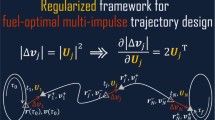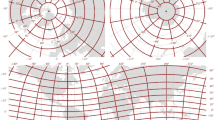Abstract
Motion equations for the gravitationally coupled orbit-attitude motion of a spacecraft are presented. The gravitational force and torque are expanded in a Taylor series in the small ratio (spacecraft size/orbital radius). A recursive definition for higher moments of inertia is introduced which permits terms up tofourth order to be retained. The expressions are fully nonlinear in the attitude variables. A quasi-sunpointing (QSP) passive attitude-control mode is used to assess the effects of higher moments of inertia and gravitational coupling. The attitude motion is detectably coupled to the orbital motion. However, the higher moments of inertia influence only the attitude motion.
Similar content being viewed by others
Abbreviations
- f G ,g G ,f Gi ,g Gi :
-
total gravitational force and torque and their components of orderi in ε=ρ/r 0
- \(h_0 , h_ \oplus \) :
-
angular momentum of spacecraft about 0 and the spacecraft mass center
- J i,I i :
-
general moment of inertia about 0 and the spacecraft mass center
- \(J, J, \rlap{--} J, I, I, \rlap{--} I\) :
-
second (dyadic), third (triadic), and fourth (tetradic) moment of inertia about 0 and the spacecraft mass center
- \(J^A , J^B , J^A , J^B , \rlap{--} J^A , \rlap{--} J^B , \rlap{--} J^{AA} , \rlap{--} J^{AB} , \rlap{--} J^{BB} \) :
-
A andB (and related components) of the second, third and fourth moments of inertia about 0, see Equation (9)
- M, m :
-
Earth's mass, spacecraft mass
- Q ba :
-
rotation matrix taking ℱa into ℱb
- \(r, r_0 , r_ \oplus \) :
-
position vector from attracting body's mass center to a general mass element, to 0 and to the spacecraft mass center
- α 1,α 2,α 3 :
-
basis vectors of reference frame ℱα
- β, Δβ, β N :
-
misalignment angle betweenb 3 and the (projected) true position of the Sun, its oscillatory component and nominal value
- δ:
-
unit dyadic (δ-identity matrix)
- ε:
-
ratio of characteristic spacecraft dimension to orbital radius
- Θ:
-
pitch angle (aboutb 2 axis)
- μ:
-
Earth's gravitational parameter
- ρ,ρ ⊗ :
-
position vector from 0 to a general mass element and the spacecraft mass center
- ψ, λ:
-
the (projected) true longitude of the Sun and the true longitude of the spacecraft
- ω α/β :
-
angular velocity of reference frame ℱα with respect to ℱβ
- (·), (*), (o):
-
d()/dt with respect to inertial space ℱ I , and orbiting frame ℱO and a body-fixed spacecraft frame ℱb
References
Mohan, S. N., Breakwell, J. V., and Lange, B. O.: 1972, ‘Interaction Between Attitude Libration and Orbital Motion of a Rigid Body in a Near Keplerian Orbit of Low Eccentricity’,Celest. Mech. 5, 157–173.
Lange, B. O.: 1970, ‘Linear Coupling Between Orbital and Attitude Motions of a Rigid Body’,J. Astronaut. Sci. XVIII, No. 3, 150–167.
Mohan, S. N.: 1970, ‘Orbital Perturbations Due to Attitude Libration of an Arbitrary Rigid Body Moving in a Central Newtonian Field’, Dept. of Aeronautics and Astronautics, Stanford University, SUDAAR Rep. No. 410.
Meirovitch, L.: 1968, ‘On the Effect of Higher-Order Inertia Integrals on the Attitude Stability of Earth-Pointing Satellites’,J. Astronaut. Sci. XV, No. 1, 14–18.
Sincarsin, G. B.: 1982, ‘Gravitational Orbit-Attitude Coupling and Penumbral Solar-Gradient Torques for very Large Spacecraft’, UTIAS Report 265.
Hughes, P. C.: 1984,Spacecraft Attitude Dynamics, (to be published).
Meirovitch, L.: 1970,Methods of Analytical Dynamics, McGraw-Hill, New York.
Woodcock, G. R.: 1977, ‘Solar Satellites-Space Key to Our Power Future’,AIAA Astronaut. Aeronaut. 15, No. 7/8, 30–43.
Elrod, B. D.: 1972, ‘A Quasi-Inertial Attitude Mode for Orbiting Spacecraft’,J. Spacecraft Rockets 9, No. 12, 889–895.
Glaser, P. E.: 1977 ‘The Potential of Satellite Solar Power’,Proc. IEEE 65, No. 8, 1162–1176.
Sincarsin, G. B.: 1982, ‘Simulation of Solar Radiation Pressure Torque on a Satellite in Earth's Penumbra’,Proceedings 10th IMACS World Congress on System Simulation and Scientific Computation, Montreal, Canada, Aug. 8–13.
Author information
Authors and Affiliations
Rights and permissions
About this article
Cite this article
Sincarsin, G.B., Hughes, P.C. Gravitational orbit-attitude coupling for very large spacecraft. Celestial Mechanics 31, 143–161 (1983). https://doi.org/10.1007/BF01686816
Received:
Accepted:
Issue Date:
DOI: https://doi.org/10.1007/BF01686816




